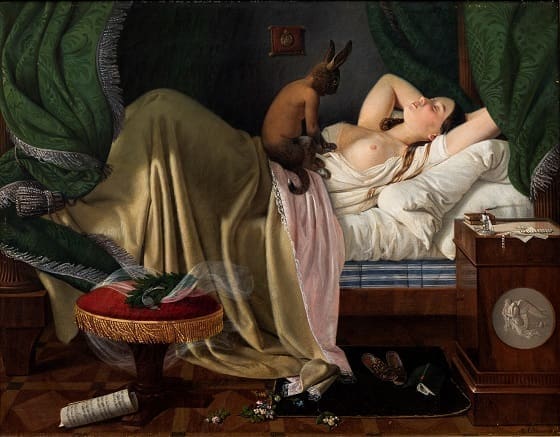Ditlev Blunck
Nightmare, 1846
Oil on canvas, 62 x 49 cm.
Inventory number: 0213NMK
Gift from Niels Risom, 2014
Sex, euphoria and even life and death are all cast alongside one another in this nightmarish painting from 1846. A messy room is illuminated by the first morning rays of light. The clock hands show that it is past six in the morning and a four-poster bed’s dressing has become a stage curtain framing the piquant drama unfolding in this scene. A demonic incubi with the head of a hare, torso of a man and backside of a cat has entered through an open window and now sits on the lap of a young woman in deep slumber. The incubi has used one of its paws to pull down her white, see-through nightdress, revealing one of her breasts. The woman, still dreaming, does not exhibit any fear or distress at the presence of the grotesque creature. On the contrary; with her closed eyes, half-parted lips and relaxed body, she appears to be in a state of sensuous pleasure. Aroused, while not aroused from her deep slumber.
In the spirit of his time, the artist has depicted the dichotomy between the civilised and somewhat prudish life of the bourgeoisie and their natural sexual urges. A gust of wind from the open window has blown the bourgeois virtues she has temporarily abandoned to the floor. The sheet of music symbolises an educational ideal that was prevalent in bourgeois homes in the 1800s. Daughters were made to study music and take piano lessons as part of their induction into (high) society. The music sheet now lies rolled up and abandoned on the parquet floor. The book, which has fallen face-down onto the carpet, shows that the young woman has cast aside the learning therein in order to surrender herself completely to her lustful urges.
Ditlev Blunck (1798-1854)
The Holsteiner Ditlev Blunck won all of the Danish Royal Academy of Art’s medals as well as a travel scholarship to Rome, where he became part of Thorvaldsen’s inner social circle. Blunck spent nearly a decade in the Italian capital, and when he finally returned to Denmark in 1838, he was sent into exile a few years later, most likely as a result of homosexual misconduct. Blunch’s art appears influenced by the academy professor J.L. Lund’s romantic depictions of real-life subjects and distinguishes itself by his stylising of the Eckerbergian naturalism. Lund and Blunck were both closely associated with the German art scene, and particularly the Nazarene’s religious fervor was prevalent in their work. The fact that Blunck even fought on the German side in the First Schleswig War helps explain why he is something of a forgotten painter in Danish art history today.


